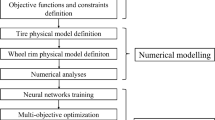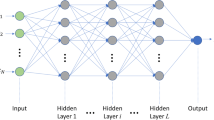Abstract
Vehicle subframes are architecturally significant and highly integrated structural components of the chassis. They have a major influence on functional chains at the overall vehicle level and are characterized by a large number of interfaces. The conflicting objectives of increased component complexity versus cross-platform design modularization require new methods and concepts aimed at more efficient development and evaluation of subframe designs across multiple stages of product maturity. This paper presents a method to cope with the complexity and uncertainties in the early development phase of structural components and to carry out a multidisciplinary as well as functional and geometric design at the detail level. First, the complexity is reduced by using automatically generated knowledge-based CAD models and corresponding FEM models, which can cover different degrees of maturity in the design process within the early development phase. Secondly, automated processes are used for all relevant requirement disciplines in order to generate data in a fast and efficient manner to train neural networks, which can map the complex and often non-linear relationships between the design parameters and the characteristic values. Thirdly, epistemic uncertainties are considered with the help of the solution space engineering framework, in which maximized solution intervals for the individual design parameters are determined, to increase robustness and flexibility for the following design process. The effectiveness of the approach is demonstrated using a rear subframe as an example problem.
Access this chapter
Tax calculation will be finalised at checkout
Purchases are for personal use only
Preview
Unable to display preview. Download preview PDF.
Similar content being viewed by others
References
Zimmermann, M., Königs, S., Niemeyer, C., Fender, J., Zeherbauer, C., Vitale, R., Wahle, M.: On the design of large systems subject to uncertainty. Journal of Engineering Design, 233-254 (2017).
Haskins, C.: Systems Engineering Handbook. 3rd edn. INCOSE, San Diego, CA (2006).
Zimmermann, M., von Hoessle, J.E.: Computing solution spaces for robust design. International Journal for Numerical Methods in Engineering, 290-307 (2013).
Fender, J., Graff, L., Harbrecht, H., Zimmermann, M.: Identifying Key Parameters for Design Improvement in High-Dimensional Systems with Uncertainty. Journal of Mechanical Design 136(4), 041007 (2014).
Hesse, S.H., Lukaszewicz, D.H.-J.A., Duddeck, F.: A method to reduce design complexity of automotive composite structures with respect to crashworthiness. Composite Structures, 236-249 (2015).
Eichstetter, M., Redeker, C., Müller, S., Kvasnicka, P., Zimmermann, M.: Solution spaces for damper design in vehicle dynamics. In: Pfeffer, P. (eds.) 5th International Munich Chassis Symposium, pp. 107-132. Springer Vieweg, Wiesbaden (2014).
Münster, M., Lehner, M., Rixen, D., Zimmermann, M.: Vehicle steering design using solution spaces for decoupled dynamical subsystems. In: International Conference on Noise and Vibration Engineering, Leuven, Belgium (2014).
Wimmler, J., Schramm, D., Wahle, M., Zimmermann, M.: Concurrent design of vehicle tires and axles. In: Pfeffer, P. (eds.) 6th International Munich Chassis Symposium, pp. 839-851, Springer Vieweg, Wiesbaden (2015).
Wimmler, J., Wahle, M., Zimmermann, M., Schramm, D.: Optimizing Suspension Systems for Feasibility, Performance and Cost. Proceedings of the 13th International Symposium on Advanced Vehicle Control, CRC Press, Munich (2016).
Wimmler, J.: On the Design of Vehicle Architectures for Driving Dynamics subject to Uncertainty and Feasibility Restrictions. DuEPublico, Duisburg-Essen (2019).
Königs, S., Zimmermann, M.: Resolving conflicts of goals in complex design processes – application to the design of engine mount systems. In: Pfeffer, P. (eds.) 7th International Munich Chassis Symposium, pp. 125-141, Springer Vieweg, Wiesbaden (2017).
Zare, A., Michels, K., Rath-Maia, L., Zimmermann M.: On the design of actuators and control systems in early development stages. In: Pfeffer, P. (eds.) 8th International Munich Chassis Symposium, pp. 337-352, Springer Vieweg, Wiesbaden (2017).
Korus, J.-D., Ramos, P.G., Schütz, C., Zimmermann, M., Müller, S.: Top-down development of controllers for highly automated driving using solution spaces. In: Pfeffer, P. (eds.) 9th International Munich Chassis Symposium, pp. 325-342, Springer Vieweg, Wiesbaden (2018).
Steber G.: Reifegradbasierter Gestaltungsprozess für Strukturbauteile im Fahrzeugbau. TEWISS Verlag, Garbsen (2019).
Kundla, M., Heussner, T., Ye, X., Schramm, D.: Evaluation of competition and virtual rear subframes by means of the data envelopment analysis. In: Bargende, M., Reuss, H.C., Wagner, A., Wiedemann, J. (eds.) 19. Internationales Stuttgarter Symposium Automobil, pp. 1201-1217, Springer Vieweg, Wiesbaden (2019).
Radaj, D., Vormwald, M.: Ermüdungsfestigkeit. 3rd edn. Springer-Verlag, Berlin Heidelberg (2007).
Burhenne, S., Jacob, D., Henze, G.P.: Sampling based on Sobol' sequences for Monte Carlo techniques applied to building simulations. In: 12th Conference of International Building Performance Simulation Association, pp. 1816-1823 (2011).
Aggarwal, C.C.: Neural Networks and Deep Learning. Springer International Publishing, Cham, 2018.
Nagelkerke, N.J.: A note on a general definition of the coefficient of determination. Biometrika 78(3), pp. 691-692 (1991).
Author information
Authors and Affiliations
Corresponding author
Editor information
Editors and Affiliations
Rights and permissions
Copyright information
© 2021 Springer-Verlag GmbH Germany, part of Springer Nature
About this paper
Cite this paper
Kundla, M. et al. (2021). Utilizing artificial neural networks and design solution spaces to cope with the complexity in subframe design. In: Pfeffer, P.E. (eds) 11th International Munich Chassis Symposium 2020. Proceedings. Springer Vieweg, Berlin, Heidelberg. https://doi.org/10.1007/978-3-662-63193-5_21
Download citation
DOI: https://doi.org/10.1007/978-3-662-63193-5_21
Published:
Publisher Name: Springer Vieweg, Berlin, Heidelberg
Print ISBN: 978-3-662-63192-8
Online ISBN: 978-3-662-63193-5
eBook Packages: EngineeringEngineering (R0)




